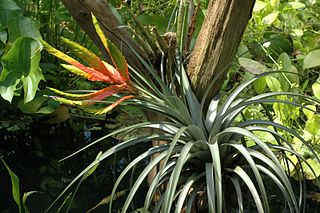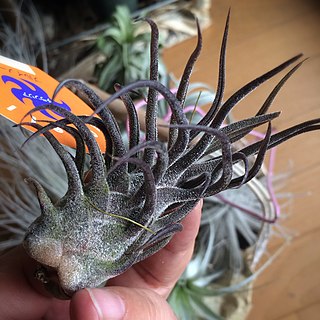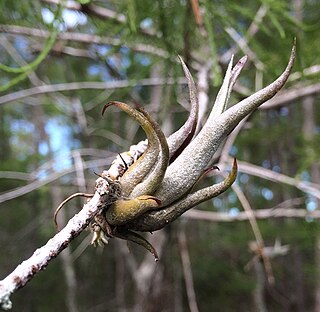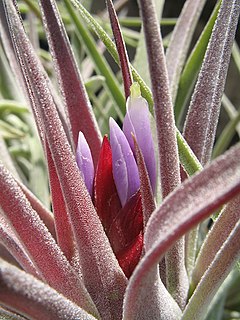
The Bromeliaceae is a family of monocot flowering plants of 75 genera and around 3590 known species native mainly to the tropical Americas, with a few species found in the American subtropics and one in tropical west Africa, Pitcairnia feliciana.

Tillandsia is a genus of around 650 species of evergreen, perennial flowering plants in the family Bromeliaceae, native to the forests, mountains and deserts of northern Mexico and south-eastern United States, Mesoamerica and the Caribbean to mid Argentina. Their leaves, more or less silvery in color, are covered with specialized cells (trichomes) capable of rapidly absorbing water that gathers on them.

Brocchinia is a genus of the botanical family Bromeliaceae, and is the sole genus of the subfamily Brocchinioideae, containing 20 species. The genus is named for Giovanni Battista Brocchi, Italian naturalist (1772–1826). Brocchinia species are native primarily to the ancient Guayana Shield in southern Venezuela and Guyana, with some species extending into Colombia and northern Brazil. Its species are generally restricted to areas of sand and sandstone of the Roraima Formation; a few occur on granite.

Puya raimondii, also known as queen of the Andes (English), titanka (Quechua) or puya de Raimondi (Spanish), is the largest species of bromeliad, its inflorescences reaching up to 15 m (50 ft) in height. It is native to the high Andes of Bolivia and Peru. It was once hypothesized to be a Protocarnivorous plant.

The Pitcairnioideae comprise the terrestrial subfamily of the bromeliads (Bromeliaceae) with over 1000 species in 16 genera. Unlike the many epiphytes and lithophytes which make up the rest of the family, with a few exceptions, all of the members of this subfamily are either terrestrial or saxicolous. Common to arid and high-altitude regions, this subfamily is considered to have the most ancient lineage, more closely resembling its grassy relatives than the exotic novelties represented in the other two subfamilies. The commonly cultivated genera from this group include Dyckia, Hechtia, Pitcairnia, and Puya.

Tillandsioideae is a subfamily of plants in the bromeliad family Bromeliaceae. This subfamily contains the greatest number of species (1,277). Most are epiphytic or lithophytic, growing in trees or on rocks where they absorb water and nutrients from the air. Spanish moss of the Tillandsia genus is a well-known variety. Bromeliads in the genera Guzmania and Vriesea are the more commonly cultivated members of this subfamily.

Puya alpestris is a species of bromeliad native to Chilean Andes. It is native to dry hills, rock outcrops in central and southern Chile at elevations of 0 to 2200 meters. It is one of the most southerly occurring species within the family. Puya alpestris is one of the few Puya species that are grown in some parks and gardens as an ornamental plant.

Tillandsia intermedia is a species in the genus Tillandsia. The species is endemic to western Mexico, reported from Guerrero, Sinaloa, and Jalisco.

Tillandsia xerographica is a species of bromeliad that is native to southern Mexico, El Salvador, Guatemala and Honduras. The name is derived from the Greek words ξηρός (xeros), meaning "dry", and γραφία (graphia), meaning "writing". It is included in Tillandsia subg. Tillandsia.

Tillandsia brachycaulos is a species in the genus Tillandsia. It is native to Mexico, Central America, and Venezuela.
Tillandsia × jaguactalensis is a natural hybrid of the genus Tillandsia. This plant is endemic to Mexico.

Tillandsia pruinosa, is a species of flowering plant in the Bromeliaceae family. It is commonly known as the fuzzywuzzy airplant. This species is native to northern South America, Central America, southern Mexico, the West Indies and Florida.

Tillandsia fasciculata, commonly known as the giant airplant or cardinal airplant, is a species of bromeliad that is native to Central America, Mexico, the West Indies, northern South America, and the southeastern United States. Within the United States, this airplant is at risk of extirpation from the Mexican bromeliad weevil, Metamasius callizona.

Tillandsia ionantha, the air plant, is a species in the genus Tillandsia. This species is native to Central America and Mexico. It is also reportedly naturalized in Broward County, Florida.

Tillandsia paucifolia, the potbelly airplant, is a species of bromeliad in the genus Tillandsia. This species is native to Central America, central and southern Mexico, Venezuela, Colombia, the West Indies, and Florida.

Tillandsia streptophylla is a species in the genus Tillandsia. This species is native to Central America, Mexico, and the West Indies.

Tillandsia utriculata, commonly known as the spreading airplant or the giant airplant, is a species of bromeliad that is native to Florida and Georgia in the United States, the Caribbean, southern and eastern Mexico, Central America, and Venezuela.
Tillandsia variabilis, the leatherleaf airplant, is a species of bromeliad in the genus Tillandsia. This species is native to Bolivia, Costa Rica, Mexico, Venezuela, Colombia, the West Indies and southern Florida.
Tillandsia baileyi, commonly known as the reflexed airplant or Bailey's ball moss, is a species of bromeliad that is native to southern Texas in the United States and Tamaulipas in Mexico. It is found along the Gulf of Mexico from Kingsville, Texas to Tampico, Tamaulipas. Preferred host plants for this epiphyte include Southern live oak and Texas ebony.

Tillandsia kammii is a species in the genus Tillandsia that is native to Honduras, but has also been collected in El Salvador. It was first discovered in Honduras in 1977 in the regions of Olancho, Lempira and Copan. Its common name is Kamm's tillandsia.
















